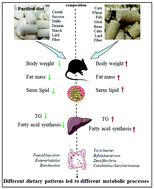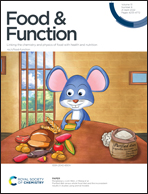Purified diet versus whole food diet and the inconsistent results in studies using animal models†
Abstract
In animal models, purified diets (PDs) and whole food diets (WFDs) are used for different purposes. In similar studies, different dietary patterns may lead to inconsistent results. The aim of this study was to evaluate and compare the effects of WFDs and PDs on changes in the metabolism of mice. We found that different dietary patterns produced different results in lipid metabolism experiments. Compared with those of the PD-fed mice, the WFD-fed mice had higher body weights and serum glucose, serum lipid, and liver lipid levels (p < 0.01), as well as low glucose tolerance (p < 0.01) and insulin sensitivity (p < 0.05). The body weight and fasting blood glucose increased by 20% in the WFD-fed mice, and the white adipose tissue weight increased by ∼50%. The WFD-fed mice also had a comparatively higher abundance of Lactobacillus, Turicibacter, Bifidobacterium, Desulfovibrio, and Candidatus saccharimonas (p < 0.01), which were positively correlated with lipid accumulation. Dietary patterns should be chosen cautiously in studies that use rodents as models. Inappropriate selection of animal dietary patterns may lead to experimental systematic errors and paradoxical results.

- This article is part of the themed collection: Food & Function HOT Articles 2022


 Please wait while we load your content...
Please wait while we load your content...